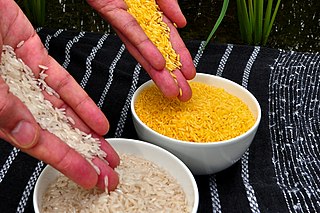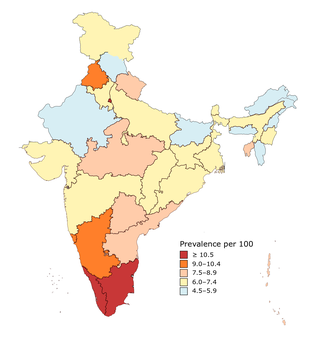
Human nutrition deals with the provision of essential nutrients in food that are necessary to support human life and good health. Poor nutrition is a chronic problem often linked to poverty, food security, or a poor understanding of nutritional requirements. Malnutrition and its consequences are large contributors to deaths, physical deformities, and disabilities worldwide. Good nutrition is necessary for children to grow physically and mentally, and for normal human biological development.

Golden rice is a variety of rice produced through genetic engineering to biosynthesize beta-carotene, a precursor of vitamin A, in the edible parts of the rice. It is intended to produce a fortified food to be grown and consumed in areas with a shortage of dietary vitamin A. Vitamin A deficiency causes xerophthalmia, a range of eye conditions from night blindness to more severe clinical outcomes such as keratomalacia and corneal scars, and permanent blindness. Additionally, vitamin A deficiency also increases risk of mortality from measles and diarrhea in children. In 2013, the prevalence of deficiency was the highest in sub-Saharan Africa, and South Asia.

Malnutrition occurs when an organism gets too few or too many nutrients, resulting in health problems. Specifically, it is "a deficiency, excess, or imbalance of energy, protein and other nutrients" which adversely affects the body's tissues and form. Malnutrition is not receiving the correct amount of nutrition.
Micronutrients are essential dietary elements required by organisms in varying quantities to regulate physiological functions of cells and organs. Micronutrients support the health of organisms throughout life.

India's population in 2021 as per World Bank is 1.39 billion. Being the world's most populous country and one of its fastest-growing economies, India experiences both challenges and opportunities in context of public health. India is a hub for pharmaceutical and biotechnology industries; world-class scientists, clinical trials and hospitals yet country faces daunting public health challenges like child undernutrition, high rates of neonatal and maternal mortality, growth in noncommunicable diseases, high rates of road traffic accidents and other health related issues.

Vitamin A deficiency (VAD) or hypovitaminosis A is a lack of vitamin A in blood and tissues. It is common in poorer countries, especially among children and women of reproductive age, but is rarely seen in more developed countries. Nyctalopia is one of the first signs of VAD, as the vitamin has a major role in phototransduction; but it is also the first symptom that is reversed when vitamin A is consumed again. Xerophthalmia, keratomalacia, and complete blindness can follow if the deficiency is more severe.

Alfred (Al) Sommer is a prominent American ophthalmologist and epidemiologist at the Johns Hopkins Bloomberg School of Public Health. His research on vitamin A in the 1970s and 1980s revealed that dosing even mildly vitamin A deficient children with an inexpensive, large dose vitamin A capsule twice a year reduces child mortality by as much as 34 percent. The World Bank and the Copenhagen Consensus list vitamin A supplementation as one of the most cost-effective health interventions in the world.

Vitamin B12 deficiency, also known as cobalamin deficiency, is the medical condition in which the blood and tissue have a lower than normal level of vitamin B12. Symptoms can vary from none to severe. Mild deficiency may have few or absent symptoms. In moderate deficiency, feeling tired, headaches, soreness of the tongue, mouth ulcers, breathlessness, feeling faint, rapid heartbeat, low blood pressure, pallor, hair loss, decreased ability to think and severe joint pain and the beginning of neurological symptoms, including abnormal sensations such as pins and needles, numbness and tinnitus may occur. Severe deficiency may include symptoms of reduced heart function as well as more severe neurological symptoms, including changes in reflexes, poor muscle function, memory problems, blurred vision, irritability, ataxia, decreased smell and taste, decreased level of consciousness, depression, anxiety, guilt and psychosis. If left untreated, some of these changes can become permanent. Temporary infertility, reversible with treatment, may occur. A late finding type of anemia known as megaloblastic anemia is often but not always present. In exclusively breastfed infants of vegan mothers, undetected and untreated deficiency can lead to poor growth, poor development, and difficulties with movement.
Sight and Life is a think tank that focuses on eliminating malnutrition in children and women of childbearing age.

Biofortification is the idea of breeding crops to increase their nutritional value. This can be done either through conventional selective breeding, or through genetic engineering. Biofortification differs from ordinary fortification because it focuses on making plant foods more nutritious as the plants are growing, rather than having nutrients added to the foods when they are being processed. This is an important improvement on ordinary fortification when it comes to providing nutrients for the rural poor, who rarely have access to commercially fortified foods. As such, biofortification is seen as an upcoming strategy for dealing with deficiencies of micronutrients in low and middle-income countries. In the case of iron, the WHO estimated that biofortification could help cure the 2 billion people suffering from iron deficiency-induced anemia.

Bangladesh is one of the most populous countries in the world, as well as having one of the fastest growing economies in the world. Consequently, Bangladesh faces challenges and opportunities in regards to public health. A remarkable metamorphosis has unfolded in Bangladesh, encompassing the demographic, health, and nutritional dimensions of its populace.

Nutrition International, formerly the Micronutrient Initiative (MI), is an international not for profit agency based in Canada that works to eliminate vitamin and mineral deficiencies in developing countries. Although often only required by the body in very small amounts, vitamin and minerals – also known as micronutrients – support an array of critical biological functions including growth, immune function and eye function, as well as foetal development of the brain, the nervous system, and the skeletal system. Micronutrient deficiency is a form of malnutrition and is a recognized health problem in many developing countries. Globally, more than two billion people live with vitamin and mineral deficiencies.
Malnutrition continues to be a problem in the Republic of South Africa, although it is not as common as in other countries of Sub-Saharan Africa.

Childhood blindness is an important contribution to the national prevalence of the disability of blindness. Blindness in children can be defined as a visual acuity of <3/60 in the eye with better vision of a child under 16 years of age. This generally means that the child cannot see an object 10 feet away, that another child could see if it was 200 feet away.
Malnutrition is a condition that affects bodily capacities of an individual, including growth, pregnancy, lactation, resistance to illness, and cognitive and physical development. Malnutrition is commonly used in reference to undernourishment, or a condition in which an individual's diet does not include sufficient calories and proteins to sustain physiological needs, but it also includes overnourishment, or the consumption of excess calories.

Undernutrition in children, occurs when children do not consume enough calories, protein, or micronutrients to maintain good health. It is common globally and may result in both short and long term irreversible adverse health outcomes. Undernutrition is sometimes used synonymously with malnutrition, however, malnutrition could mean both undernutrition or overnutrition. The World Health Organization (WHO) estimates that malnutrition accounts for 54 percent of child mortality worldwide, which is about 1 million children. Another estimate, also by WHO, states that childhood underweight is the cause for about 35% of all deaths of children under the age of five worldwide.

Child health and nutrition in Africa is concerned with the health care of children through adolescents in the various countries of Africa. The right to health and a nutritious and sufficient diet are internationally recognized human rights that are protected by international treaties. Millennium Development Goals (MDGs) 1, 4, 5 and 6 highlight, respectively, how poverty, hunger, child mortality, maternal health, the eradication of HIV/AIDS, malaria, tuberculosis and other diseases are of particular significance in the context of child health.
Howarth E. "Howdy" Bouis, is an American economist whose work has focused on agriculture, nutrition outcomes, and reducing micronutrient malnutrition, also known as hidden hunger. He is the founder and former director of HarvestPlus, a global non-profit agricultural research program. Bouis was awarded the World Food Prize in 2016 for his pioneering work on biofortification.

India has an estimated 77 million people formally diagnosed with diabetes, which makes it the second most affected in the world, after China. Furthermore, 700,000 Indians died of diabetes, hyperglycemia, kidney disease or other complications of diabetes in 2020. One in six people (17%) in the world with diabetes is from India. The number is projected to grow by 2045 to become 134 million per the International Diabetes Federation.














